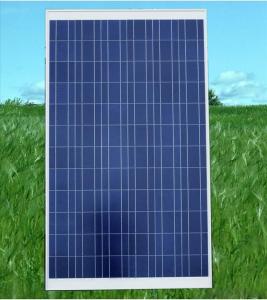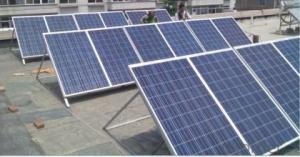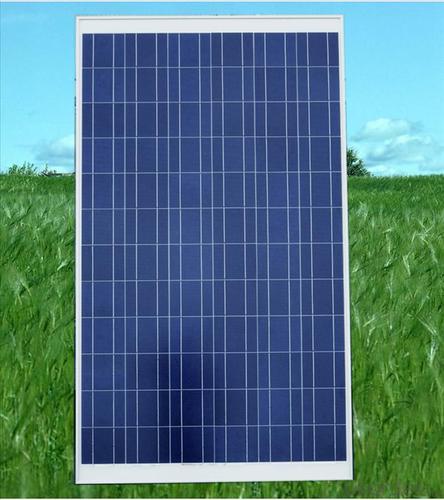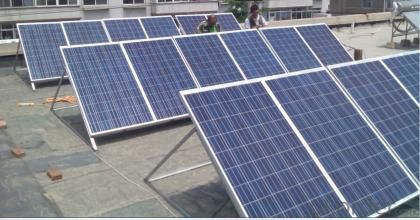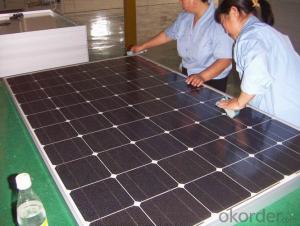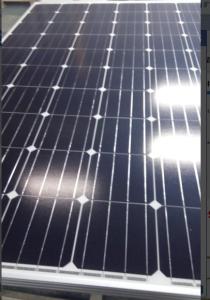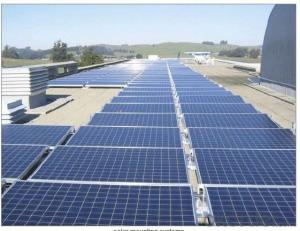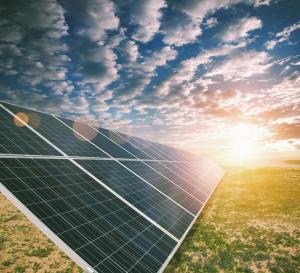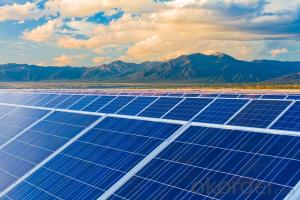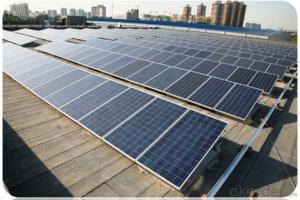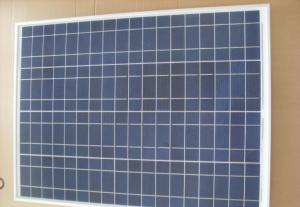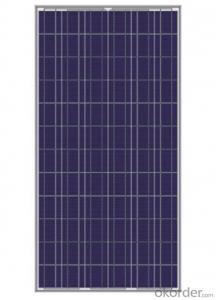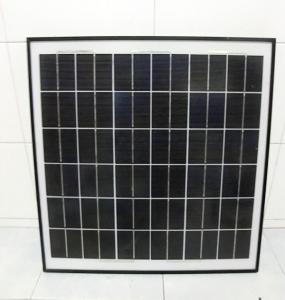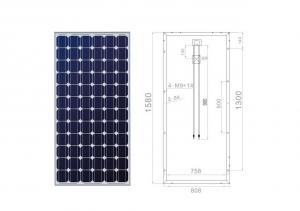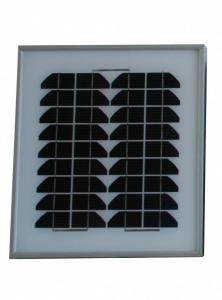Ksp Solar Panels (30w) CNBM Solar Polycrystalline 6 Series
- Loading Port:
- China main port
- Payment Terms:
- TT OR LC
- Min Order Qty:
- 100000 watt
- Supply Capability:
- 10000000 watt/month
OKorder Service Pledge
OKorder Financial Service
You Might Also Like
About us
CNBM International Corp, established in 2004, is the business entity for trade and logistic of CNBM Group.With the advantages in Cement, Composite Materials, New Building Materials and Engineering, CNBM mainly concentrate on coal, steel and construction equipments and give priority to solar and wind energy development.CNBM International is highly recognized by its business partners and clients all over the world and has established good business relationship with the customers in over 120 countries and regions all over the world.
Work Principle

Data sheet
| Characteristics | |
| Max Power Voltage Vmp (V) | 17.6V |
| Max Power Current Imp (A) | 1.70A |
| Open Circuit Voltage Voc (V) | 22.6V |
| Short Circuit Current Isc (A) | 1.82A |
| Max Power Pm (W) | 30W |
| Temperature Coefficient of Cells | |
| NOCT | 47℃±2℃ |
| Temperature Coefficients of Isc (%/℃) | 0.06% |
| Temperature Coefficients of Voc (%/℃) | -0.33% |
| Temperature Coefficients of Pmp (%/℃) | -0.45% |
| Mechanical Data | |
| Type of Cells (mm) | Poly156×31.2 |
| Dimension | 510×450×25mm |
| Weight | 2.7kg |
| NO.of Cells and Connections | 3×12=36 |
| Limits | |
| Operating Temperature | –45°C to +80°C |
| Storage Temperature | –45°C to +80°C |
| Max System Voltage | 700V |

FAQ:
1. How long will my inquiry get response?
Your inquiry related to our products or prices will be replied within 24 hours.
2. Can I get professional service and suggestion?
Well-trained and experienced staffs to answer all your questions in fluent English.
3. Do you accept OEM or customized design?
OEM & ODM, any your customized lightings we can help you to design and put into product.
4. What if I need specific design?
Distributorship are offered for your unique design and some our current models.
- Q: Why might energy from the solar panels sometimes be near zero even in the summer?
- Solar panels are a little like batteries or christmas lights, they are often connected in series, if something is wrong in a string of them, current simply won't flow just like how all the lights in some christmas lights go out if one bulb goes out and you have to find the bad bulb by replacing bulbs one at a time.
- Q: i have to do a science fair project and thought it would be cool to make a solar powered vw bus. i have 2 6volt solar panels to power a dc motor that works off of 9v 2v or 8v. i also bought a 2nd motor because the first wasnt workin for us. this one is a 3v motor. ive had them in the sun but they wont work. please help, thanks
- Ok okorder
- Q: Hi, I have in my sailboat 2 2 V batteries. I would like to buy solar panel(s) in order to recharge them. As i am in mexico and there is always high sun . i think it is a good idea.Usage of the batteries is very light . I have found 5-2V pannels with 80mA that fit in the sailboat. I want to know if and how i can have like 5 to 0 of them set together to charge the batteries and what other material would i need.also, i would like to know what happend if the pannels only send on 5V in a 2 V battery? Is it still charging but on 40 % of the capacity a 2 v pannel would charge or its just not doing nothing ?
- 0 of the panels wired in parrell will give you enough power to trickle charge the batteries. You will need a charge controller to prevent a overcharge from damaging your batteries. A panel array that is rated at 2 volts actually puts out a unregulated voltage up to 2 volts. I have bought some charger controllers from OKorder at good prices. They will also prevent the discharge of your batteries at night or when the panels are in the shade. If the panels only put out 5 volts they will not charge the batteries. Check each panel outside in the sun with a DC volt meter for proper operation before connecting them.
- Q: i already have solar/gas water heating, but was wondering if getting solar panels for electricity installed was a good idea.
- Create okorder
- Q: can solar power panels installed at home provide enough electricity to power house hold appliainces and heat water.
- It will take about $44,000 to put enough solar panels to provide the same amount of power that you now have coming from a 220 v 00 amp power line to your house. You should also realize that you need some method of storage for use at night or dark days. This will add another $7,000 to the cost. The only real solution for the energy problem is nuclear power.
- Q: Can solar panels be used to power a farm?
- Yes, solar panels can be used to power a farm. They can generate electricity from sunlight, which can be utilized to operate various farming activities such as irrigation systems, lighting, and machinery. Solar power offers a sustainable and renewable energy solution for farms, reducing dependence on traditional fossil fuel-based electricity and potentially reducing operating costs.
- Q: What do these mean? I'm interested in doing a solar panel project. The problem is I know nothing about electricity, wiring, or panels so I've bought a small panel to experiment with first.I don't know what amps, watts, or volts are; what I should be reading on the batteries I will be charging? Or on the small appliances I will be running?The panel I bought has four settings:. 3V ---- 200mA2. 6V ---- 00 mA3. 9V ---- 50mA4. 2V ---- 50 mA(What is mA?)Also, will you give examples of what I can run with this? Make up any scenarios with whatever amps/volts/watts.
- okorder / to see our solar panel project.
- Q: Solar Panels not working very well, they have faded. Is there any paint or anything else I can do to restore them? Thanks Eileen
- Unfortunately Eileen the panels are bound to fade as its par for the course. Over time much like everything else (from an AC condenser to your knees and hips) everything starts to go south. When did you purchase and install your panels? If this was done within the past few years then something is definitely wrong, and you should have the manufacturer and installer come back and replace the panels....on their dime of course. Is the warranty on your panels still in effect? If so then its definitely something that they have to come back and take care of. There is a company I know of called Sun Electronics that has a 20 year warranty on their products, so if its worth anything you might want to buy your new panels/system from them. The panels around today are more efficient than those of years past, and with the cost coming down due to economies of scale and the tax incentives you might want to consider getting a new system. Sorry to let you down though Eileen!
- Q: Can solar panels be installed on wineries or vineyards?
- Yes, solar panels can be installed on wineries or vineyards. In fact, many wineries and vineyards around the world have adopted solar energy systems to power their operations and reduce their carbon footprint.
- Q: Can solar panels be used in areas with high levels of air humidity or moisture?
- Yes, solar panels can be used in areas with high levels of air humidity or moisture. However, it is important to note that excessive moisture can affect the performance of solar panels over time. Therefore, proper installation, regular maintenance, and periodic cleaning are crucial to ensure their efficiency and longevity in such environments.
Send your message to us
Ksp Solar Panels (30w) CNBM Solar Polycrystalline 6 Series
- Loading Port:
- China main port
- Payment Terms:
- TT OR LC
- Min Order Qty:
- 100000 watt
- Supply Capability:
- 10000000 watt/month
OKorder Service Pledge
OKorder Financial Service
Similar products
Hot products
Hot Searches
Related keywords
